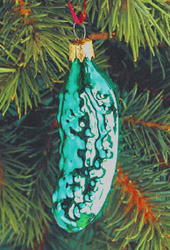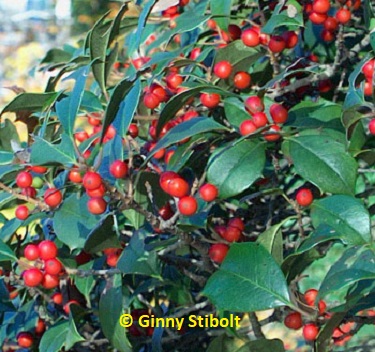Holly, ivy, and more…
by Ginny Stibolt
This column is the second part of a discussion of greenery used for
holiday décor. This time I discuss legends and botanical information
on holly, ivy, and the unfortunate Christmas pickle. The previous column
covered mistletoe and magnolias.
Hollies
Hollies are one of the few trees found in all fifty states, and indeed
are found in much of the world. The Christmas legends based on the evergreen
English holly (Ilex aquifolium), which most resembles our American
holly (Ilex opaca). This holly is native in the whole southeast
including this region of Florida. A classic holly, it has dark shiny
evergreen leaves with sharp spines. But keep in mind that even though
it’s evergreen, the holly will lose its old leaves in the spring after
the new leaves are fully formed. Years ago, I read article in a garden
magazine said to plant hollies around your pool because there are no
leaves to clean up. Obviously the author had no experience with stepping
on those hard, sharp holly leaves with bare feet. Ouch!
Almost all hollies are dioecious which means that trees will bear either
male or female flowers but not both. The female tree is the one with
all those attractive berries. (Nurseries may label whether a holly is
a male or a female. If you know the parts of a flower, you can identify
the gender of a tree in the spring when they bloom. Be sure there is
at least one male tree in the neighborhood or your female trees won’t
produce berries.) Hollies grow best in acidic soil and require little
care. The USDA reports that the biggest destroyer of this holly is not
disease or insects, but people harvesting its branches for the Christmas
trade!
Holly legends abound. As we discussed in the last column, holly was
included in the evergreens brought in during the winter to provide
safe haven for the gods of spring; but it was especially prized
because of its shiny leaves and its ability to bear fruit in winter.
Some people used holly bark to make a syrup to cure coughs; others
hung it over their beds to produce good dreams. Holly was a popular
Saturnalia gift among the Romans (The Roman celebration at the winter
solstice honored their god, Saturn.) who later brought holly to
England, where it was also considered sacred. The Christians adapted
the legends; and during some periods of history, it was called the
holy tree. Some say that the sharp leaves symbolized the crown of
thorns and the red berries symbolized the blood of Christ. Legend says
that hollies sprang forth wherever He walked.
A Celtic holly legend pits the twin brothers, the Holly King and
the Oak King, against each other to explain winter & summer, good
& evil, dark & light and more. Somewhere in this story, we
also meet Robin Hood, St. George who slew the dark Turkish knight who
turned out to be his brother, St. Nicholas disguised as the Holly King,
and more. In the carol “The Holly and the Ivy” the words allude to
these struggles and the holly wins during the winter because it’s
evergreen. “The holly and the ivy, When they are both full grown, Of
all the trees that are in the wood, The holly bears the crown.”
Ivy
Ivy’s tradition as a Christmas plant (aside from the carol) has not
widely carried over from England, but the plant itself (Hedera helix)
has become a noxious weed in many parts of the country. In the ravine
next to my house in Maryland, mature stands of ivy climb up all the
trees. The ivy plant becomes mature and bears its black berries after
a decade or more of climbing on an object. If it is not allowed to climb,
it remains in its juvenile vine form. If you root a cutting from mature
growth ivy, it will be an upright bush with more oval-shaped leaves
and not a vine.
At some point, genders were assigned, and because holly is strong,
it represents the male. Ivy’s clinging habit and need to lean on
something to grow, assigned it the female role. Ironically, if you
look at the botany, those highly-prized holly boughs with the
magnificent red berries are from female trees!
Holly and ivy have been used together to create kissing balls to substitute
for mistletoe when
it was thought to be too evil for use as Christmas décor. It was considered
to be bad luck if there was more ivy than holly in the ball, though.
Later mistletoe was added back into the mix.
Ivy was associated with Bacchus, the Roman god of wine, and thought
to bring good luck and joy. (I always assumed that the vine pictured
with Bacchus was grape, but with further research I found that ivy is
the winter vine, while grape is the summer vine for Bacchus.) Like other
evergreens, ivy was seen as a symbol of eternal life. Growing the plant
on the outside walls of a house was believed to be a deterrent against
misfortune. However, if it died, it was thought that financial trouble
was approaching. Those of us who’ve had the misfortune of having
to scrape ivy from our houses and repair the damage to shingles, window
frames, and anything else with a crevice might argue with this legend.
The unfortunate Christmas pickle legend
The story goes that it’s an old, but little known, German tradition
that the last ornament hung on the Christmas tree is a pickle-shaped
glass ornament. The first child on Christmas morning to find the
well-hidden ornament receives an extra present from St. Nicholas.
According to Hyde Flippo in his, German
Christmas Pickle Tradition, there are two flaws: no one in Germany
has heard of this as a tradition, and St. Nick didn’t traditionally
come on Christmas Eve. The one possible connection to Germany is that
in 1847, craftsmen in the small town of Lauscha began producing glass
ornaments in the shape of fruits and nuts using a unique hand-blown
process combined with molds. Today Lauscha exports pickle ornaments
to the US—where they are sold along with the spurious German tradition
story.
I queried Kerstin and Annika Ebsen, who live in Germany today about
this. They wrote, “They blame the people in the East of Germany of
that pickle custom-?! …where they didn't have fresh fruits and
therefore took a pickle instead of an apple to decorate their trees.
(Which was a joke, anyway.)”
There are two other versions of the origins of the Christmas
pickle. One is a family story of a Bavarian-born ancestor who fought
in the American Civil War. A prisoner in poor health and starving, he
begged a guard for just one pickle before he died. The guard took pity
on him and found a pickle for him. The pickle—by the grace of
God—gave him the mental and physical strength to live on.
The other, perpetuated in Berrien Springs, MI, is a medieval tale
of two Spanish boys traveling home from boarding school for the
holidays. When they stopped at an inn for the night, the innkeeper, a
mean and evil man, stuffed the boys into a pickle barrel. That
evening, St. Nicholas stopped at the same inn, became aware of the
boys' plight, tapped the pickle barrel with his staff, and the boys
were magically freed.
Berrien Springs calls itself the Christmas Pickle Capital of the
World. They celebrate with an annual Christmas Pickle Festival held
during the early part of December. A parade, led by the Grand
Dillmeister who passes out fresh pickles along the parade route, is
the featured event. You may even purchase the German glass pickle
ornaments at the town’s museum.
Oh by the way, Berrien Springs is the heart of pickle-packing country.
Are they pulling our collective legs for commercial gain?
|



